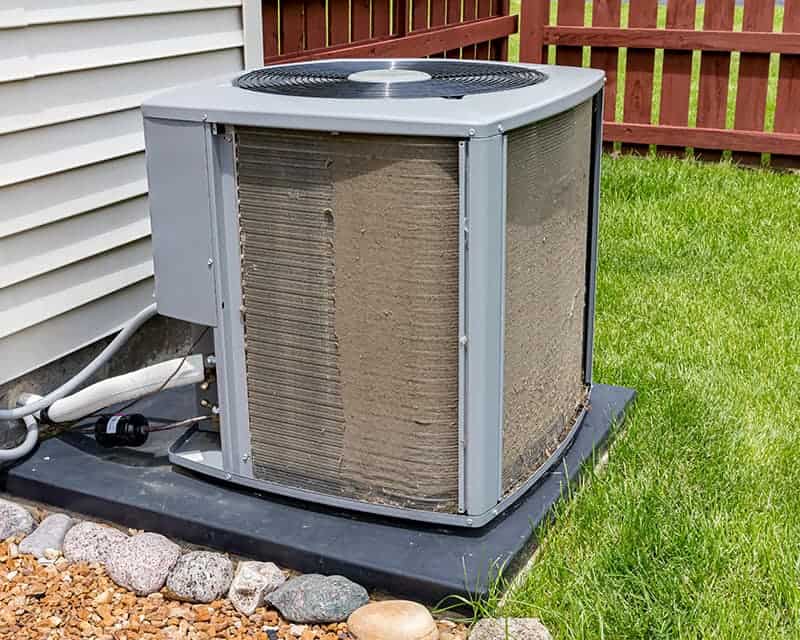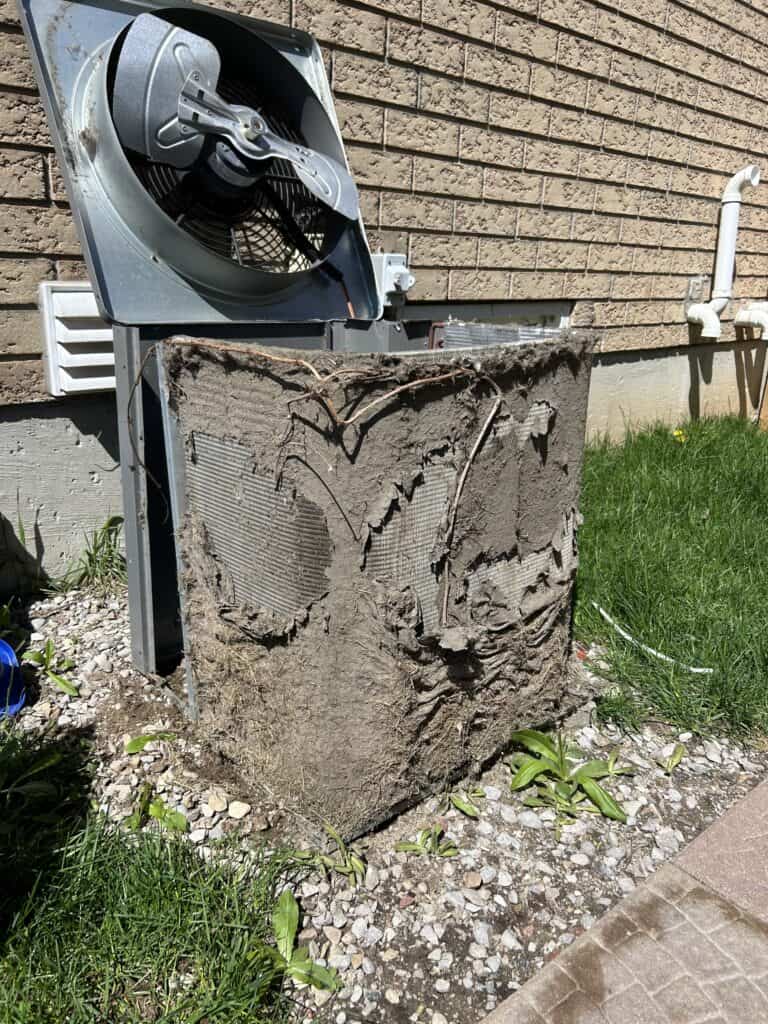If your air conditioner isn’t blowing cold air, the usual culprits include refrigerant leaks, dirty or blocked coils, and faulty compressors. To tackle these, first check for hissing sounds, which can indicate a refrigerant leak.
You’ll need a professional to fix leaks and refill the coolant. Next, clean your AC’s coils with a coil cleaner and a soft brush to remove dirt-blocking heat exchange.
If your compressor makes unusual noises or doesn’t run, it might need replacement. Regularly replacing your air filters also guarantees ideal airflow and cooling efficiency. More nuanced solutions await further exploration into specific A/C maintenance nuances.
Understanding Why Your Air Conditioner Isn’t Blowing Cold Air

When your air conditioner doesn’t blow cold air, it usually has a few common problems. Knowing about these issues can help you figure out if you’re dealing with a simple filter blockage or a more complex refrigerant leak.
Common Symptoms of Air Conditioner Issues
You can tell your air conditioner isn’t working right if it makes weird noises, has weak airflow, or gets ice on it. Hissing sounds often mean there’s a refrigerant leak. Ice on the lines can also point to similar issues, which mess up how well it works and how efficient it is.
You might also see dirty or blocked coils. This makes it harder for the unit to exchange heat, so it has to work more and uses extra energy.
Clogged filters also really get in the way of the cooling process. It’s important to deal with these symptoms quickly. Ignoring them won’t just leave you uncomfortable; it’ll also lead to higher bills and maybe even system failures, keeping you from the cool relief you want.
Common Causes of Air Conditioner Cooling Problems

If your air conditioner isn’t blowing cold air, you may be facing one of several common issues. Refrigerant leaks, for instance, can greatly reduce cooling efficiency, while dirty or blocked coils struggle to dissipate heat properly.
Moreover, a faulty compressor or thermostat problems could be preventing your system from operating correctly, alongside potential airflow obstructions that hinder overall performance. In addition, issues with duct insulation or leaks might lead to significant energy loss, resulting in increased utility bills. When these factors combine, weak air from vents causes discomfort in your space and can lead to greater strain on your HVAC system. Regular maintenance can help identify and resolve these issues before they escalate into more serious problems.
Refrigerant Leaks
Refrigerant leaks often cause your air conditioner to stop blowing cold air, as they directly impact the system’s ability to cool efficiently.
If you notice reduced cooling or increased energy bills, it’s important to seek professional leak repair.
Regular maintenance includes checking and refilling refrigerant levels. A timely refrigerant recharge can restore efficiency and prevent poor cooling, ensuring you’re part of a comfortably cool community.
Dirty or Blocked Coils
Dirty or blocked coils are another common reason your air conditioner may fail to deliver cold air. Regular cleaning and maintenance of your evaporator coil are essential.
Use a coil cleaner and a soft brush to gently remove debris. A fin comb can straighten any bent fins, ensuring peak airflow.
Don’t forget to check for blocked vents, which can hinder your unit’s efficiency.
Faulty Compressor
Another potential cause when your air conditioner fails to cool effectively is a faulty compressor. The compressor is crucial for circulating refrigerant and maintaining airflow.
Here’s what you can do:
- Diagnose: Check if the unit turns on and listen for any unusual noises.
- Regular Checks: It’s important to maintain routine inspections to spot potential issues early.
- Replace Compressor: If the diagnosis confirms a faulty compressor, consider replacing it to restore cooling efficiency.
Thermostat Problems
Your air conditioner’s inefficiency might also stem from thermostat issues, which can mislead the system about the actual room temperature. Calibration issues or incorrect settings could be at fault.
Ensuring proper thermostat function might require re-calibration or even upgrading to a smart thermostat. This upgrade can help you join others enjoying precise temperature control and efficiency, effectively resolving common thermostat problems in your cooling system.
Airflow Obstructions
Blocked air filters or ducts greatly reduce the efficiency of your air conditioner by obstructing the airflow necessary for cooling.
Here’s how you can tackle this:
- Replace Filters: Use the right filter type and replace them monthly.
- Clear Blockages: Regularly check and clear any blockages in ducts.
- Testing and Adjustments: Conduct monthly testing and make necessary adjustments to guarantee peak performance.
Preventative Maintenance Tips for Air Conditioners

To make sure your air conditioner works well and avoids common issues like not blowing cold air, you should regularly clean or replace its filters. Seasonal HVAC inspections can catch potential problems before they get worse, keeping your system running smoothly.
Moreover, checking and refilling refrigerant levels, along with maintaining the cleanliness of the coils and verifying proper thermostat function, are vital steps in preventative maintenance.
Cleaning and Replacing Air Filters
Regularly cleaning and replacing the air filter in your air conditioner guarantees peak performance and prevents common issues like reduced airflow. You’re part of a community that values smart, proactive maintenance.
Here’s how you can maintain your AC’s health:
- Check and Clean Monthly: Inspect the filter every month, especially during heavy-use seasons. Clean dust and debris to maintain airflow and efficiency.
- Replace Quarterly: Swap out old filters every three months. This routine ensures early detection of potential problems and sustains improved efficiency.
- Align with Seasonal HVAC Inspections: While replacing, align it with your seasonal HVAC inspections to optimize the unit’s performance and longevity.
Seasonal HVAC Inspections
Aligning your filter replacement with seasonal HVAC inspections guarantees that your air conditioner stays in peak condition year-round. These inspections are vital as they ensure all components function efficiently, preventing unexpected breakdowns during extreme weather. Here’s a table to guide you on what to check and why:
| Component | Reason for Inspection |
|---|---|
| Electrical Connections | Ensure they’re tight and free from corrosion |
| Condenser Coil | Check for blockages and clean to maintain airflow |
| Thermostat | Verify accuracy for best performance |
| Drain Line | Clear to prevent water damage and mold growth |
Checking Refrigerant Levels
You should check and refill your air conditioner’s refrigerant levels to guarantee maximum cooling efficiency. Low refrigerant can cause your system to work harder, increasing energy costs and reducing its lifespan.
Here’s how to ensure peak performance:
- Identify Signs of Low Refrigerant: Watch for ice buildup on the coils, hissing noises, or reduced cooling capacity. These symptoms suggest a refill might be necessary.
- Check for Leaks: Before adding more refrigerant, make sure there aren’t any leaks. Use a leak detector or soapy water to spot any escaping gas.
- Refill Correctly: If you’re experienced, you can refill the refrigerant yourself, but it’s often best to hire a professional to ensure the correct type and amount is used.
Maintaining AC Coils
To guarantee the peak performance of your air conditioner, it’s crucial to keep the coils clean and free from debris. Dirty coils can greatly reduce efficiency and increase energy costs.
Start by turning off the power to your unit to ensure safety. You’ll want to remove any protective grilles and use a soft brush or a vacuum with a brush attachment to gently remove dirt from the evaporator and condenser coils. For more stubborn grime, apply a commercially available coil cleaner, following the instructions closely.
Make this a regular part of your AC maintenance – ideally, before the cooling season begins and once midway through. By doing so, you’re not just looking after your system; you’re ensuring you remain a comfortable and proactive member of your household.
Verifying Thermostat Accuracy
Double-check your thermostat settings to make sure they accurately reflect your cooling needs and that the device is functioning correctly. A malfunctioning thermostat can lead to inefficiencies and excessive wear on your AC system. Here are some steps to confirm it’s working properly:
- Verify Calibration: Make sure your thermostat is calibrated correctly to provide the most accurate readings. You might need a professional to recalibrate it if discrepancies continue.
- Check Location: Your thermostat shouldn’t be located near heat sources or in direct sunlight. This can cause it to misread the actual room temperature.
Update: Consider upgrading to a programmable thermostat if yours is outdated. This allows for better temperature management and energy savings.














